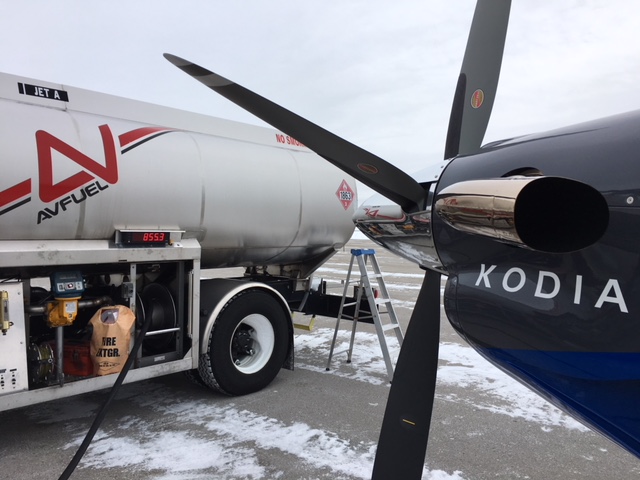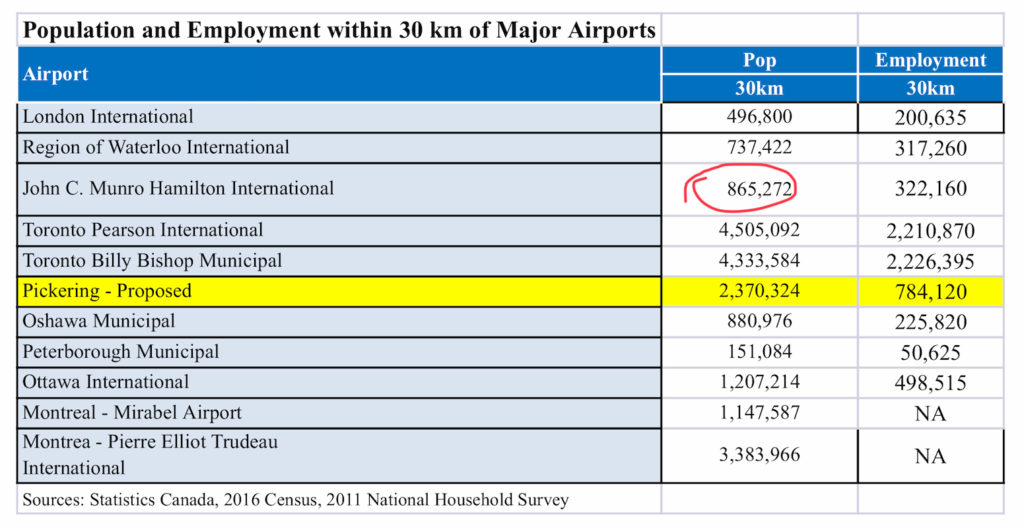
Opponents of Pickering airport often point to Hamilton airport as a possible solution to the Toronto regions jet airport capacity limitations. Hamilton politicians and business leaders think so, but does building out Hamilton airport offer a real solution? The tyranny of geography and logistics has other ideas. It turns out that Hamilton is not economically or environmentally efficient.
Hamilton airport has two serious limitations compared to Pickering. The first is its location, including distance from downtown Toronto and distance and access to regional population centers. The second is lack of accessibility to fuel via rail and or pipeline.
As the old realestate saying goes, location , location, location! Pickering airport is only half the distance from key population centers in the Toronto region compared to Hamilton airport. To get an idea of how much more efficient the Pickering site will be as a reliever airport, consider population location and accessibility. 2,300,000 people live within a 30 km radius of Pickering airports proposed site. Less than 870,000 people live within a 30km radius of Hamilton airport.
While both airports have road and freeway access, the average Toronto region resident will have to travel twice the distance to Hamilton than to Pickering airport. For the several million residents living north and east of Toronto ( along the 404 hwy corridor as an example), Pickering airport is only a 20-40 km drive. For these residents, Hamilton airport is a 100-120 km road trip away. Add in the need to drive through some of of Toronto’s worse traffic and around the Niagara escarpment to the other side of Hamilton to reach its airport, and you might as well keep driving to Buffalo. Every year, hundreds of thousands of Toronto residents do just that. They drive to Buffalo New York rather than Hamilton to get a flight. Over the years a number of start up airlines, even west jet, have tried to operate out of Hamilton with little success.

Hamiltons second problem is a more insidious one, economical and safe access to jet fuel. A single Boeing 777 on its way from Pearson to Japan will need 120,000 liters of Jet fuel and half an hour to fill up. A single Boeing 747 could take up to 6 Semi Trailer truck loads of Jet-A to fill up. Pearson solves this problem for its 1200 daily flights with a pipeline of Jet fuel right from the Westover terminal, a major pipeline hub that services the Toronto region. This same pipeline ( run by Trans-Northern) passes just south of the Pickering airport site. Hamilton has no such easy access and just as importantly does not have access to rail.
Aviation Fueling of Toronto, the consortium that owns and operates the fueling infrastructure at Pearson, uses the pipeline and also uses rail cars for redundancy to fill a satellite tank farm near Pearson airport. Pickering will have this same advantage as a rail line goes thought the Pickering airport site.
Hamilton, cutoff from both the advantages of rail and a pipeline, must gets its fuel by road. At Hamilton, a competing Consortia uses tanker trucks that haul jet fuel to fill two aboveground tanks. While this works now for the approximately 35,000 aircraft flights fueled annually, it is inherently more costly, less efficent and less safe. Scaling this up as both the size of aircraft , and the number of flights increases 10 fold does not seem plausible.
An accident this summer on highway 400 is a stark reminder of the safety issues around increasing the number of tanker trucks on our roads, especially in densely populated areas. You can see the CBCs coverage of this accident here:
http://www.cbc.ca/news/canada/toronto/highway-400-fatal-pileup-cookstown-1.4381540
Transforming Hamilton into a true reliever airport for the Toronto region could mean a hundred additional semi-trailer fuel trucks a day on area roads carrying jet fuel. A new pipeline could be built, most likely from an existing TransNorthern pipeline to the south in the town of Binbrook. Alternatively a longer pipeline could also be built from the Westover terminal to the North. Both would require the political will to expropriate the right of ways. This pipeline effort, expense, and land used, combined with rebuilding Hamilton airport for its new role, would equal that of building the first stage of Pickering airport.
It seems that the original team that selected the Pickering land to future proof Toronto’s aviation infrastructure knew what they where doing. Hamilton will always have a role to play in a pinch, but Pickering is the only real location available to solve Toronto’s Jet airport capacity squeeze.